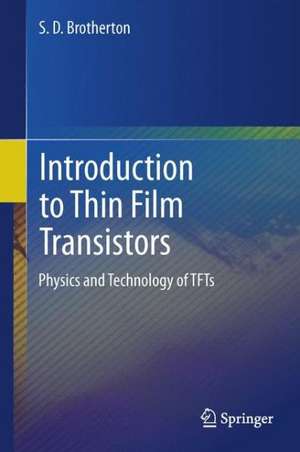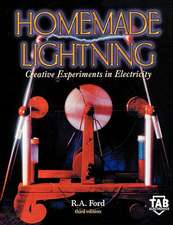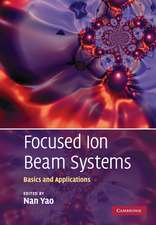Introduction to Thin Film Transistors: Physics and Technology of TFTs
Autor S.D. Brothertonen Limba Engleză Hardback – 29 mai 2013
The large scale manufacturing of a-Si:H TFTs forms the basis of the active matrix flat panel display industry. Poly-Si TFTs facilitate the integration of electronic circuits into portable active matrix liquid crystal displays, and are increasingly used in active matrix organic light emitting diode (AMOLED) displays for smart phones. The recently developed AOS TFTs are seen as an alternative option to poly-Si and a-Si:H for AMOLED TV and large AMLCD TV applications, respectively. The organic TFTs are regarded as a cost effective route into flexible electronics.
As well as treating the highly divergent preparation and properties of these materials, the physics of the devices fabricated from them is also covered, with emphasis on performance features such as carrier mobility limitations, leakage currents and instability mechanisms. The thin film transistors implemented with these materials are the conventional, insulated gate field effect transistors, and a further chapter describes a new thin film transistor structure: the source gated transistor, SGT.
The driving force behind much of the development of TFTs has been their application to AMLCDs, and there is a chapter dealing with the operation of these displays, as well as of AMOLED and electrophoretic displays. A discussion of TFT and pixel layout issues is also included.
For students and new-comers to the field, introductory chapters deal with basic semiconductor surface physics, and with classical MOSFET operation. These topics are handled analytically, so that the underlying device physics is clearly revealed.These treatments are then used as a reference point, from which the impact of additional band-gap states on TFT behaviour can be readily appreciated.
This reference book, covering all the major TFT technologies, will be of interest to a wide range of scientists and engineers in the large area electronics industry. It will also be a broad introduction for research students and other scientists entering the field, as well as providing an accessible and comprehensive overview for undergraduate and postgraduate teaching programmes.
| Toate formatele și edițiile | Preț | Express |
|---|---|---|
| Paperback (1) | 707.13 lei 43-57 zile | |
| Springer International Publishing – 18 iun 2015 | 707.13 lei 43-57 zile | |
| Hardback (1) | 721.85 lei 43-57 zile | |
| Springer International Publishing – 29 mai 2013 | 721.85 lei 43-57 zile |
Preț: 721.85 lei
Preț vechi: 849.24 lei
-15% Nou
Puncte Express: 1083
Preț estimativ în valută:
138.17€ • 150.13$ • 116.14£
138.17€ • 150.13$ • 116.14£
Carte tipărită la comandă
Livrare economică 21 aprilie-05 mai
Preluare comenzi: 021 569.72.76
Specificații
ISBN-13: 9783319000015
ISBN-10: 3319000012
Pagini: 504
Ilustrații: XV, 488 p.
Dimensiuni: 155 x 235 x 32 mm
Greutate: 1.11 kg
Ediția:2013
Editura: Springer International Publishing
Colecția Springer
Locul publicării:Cham, Switzerland
ISBN-10: 3319000012
Pagini: 504
Ilustrații: XV, 488 p.
Dimensiuni: 155 x 235 x 32 mm
Greutate: 1.11 kg
Ediția:2013
Editura: Springer International Publishing
Colecția Springer
Locul publicării:Cham, Switzerland
Public țintă
ResearchCuprins
Introduction.- Semiconductor Device Physics for TFTs.- Insulated Gate Field Effect Transistors, IGFETs.- Active Matrix Flat Panel Displays.- Hydrogenated Amorphous Silicon TFT Technology and Architecture.- Hydrogenated Amorphous Silicon TFT Performance.- Poly-Si TFT Technology and Architecture.- Poly-Si TFT Performance.- Transparent Amorphous Oxide Semiconductor TFTs.- Organic TFTs.- TFTs on Flexible Substrates.- Source-Gated Transistors.
Notă biografică
One of the pioneers in the field of Si-based TFT devices and technology, S D Brotherton is an established expert and authoritative figure with an extremely high standing in the community. He is both a prolific researcher and technologist: exactly the combination needed for this type of book.
He has a background in physics and mathematics, and has recently retired as project leader of Solid State Devices at Philips Research Labs in the UK with a focus on TFTs. During his career, he has published 117 articles in well-established applied physics and electrical engineering journals. He is also one of the Editors of the Handbook of Visual Display Technology.
He has a background in physics and mathematics, and has recently retired as project leader of Solid State Devices at Philips Research Labs in the UK with a focus on TFTs. During his career, he has published 117 articles in well-established applied physics and electrical engineering journals. He is also one of the Editors of the Handbook of Visual Display Technology.
Textul de pe ultima copertă
Introduction to Thin Film Transistors reviews the operation, application, and technology of the main classes of thin film transistor (TFT) of current interest for large area electronics. The TFT materials covered include hydrogenated amorphous silicon (a-Si:H), poly-crystalline silicon (poly-Si), transparent amorphous oxide semiconductors (AOS), and organic semiconductors.
The large scale manufacturing of a-Si:H TFTs forms the basis of the active matrix flat panel display industry. Poly-Si TFTs facilitate the integration of electronic circuits into portable active matrix liquid crystal displays, and are increasingly used in active matrix organic light emitting diode (AMOLED) displays for smart phones. The recently developed AOS TFTs are seen as an alternative option to poly-Si and a-Si:H for AMOLED TV and large AMLCD TV applications, respectively. The organic TFTs are regarded as a cost effective route into flexible electronics.
As well as treating the highly divergent preparation and properties of these materials, the physics of the devices fabricated from them is also covered, with emphasis on performance features such as carrier mobility limitations, leakage currents and instability mechanisms. The thin film transistors implemented with these materials are the conventional, insulated gate field effect transistors, and a further chapter describes a new thin film transistor structure: the source gated transistor, SGT.
The driving force behind much of the development of TFTs has been their application to AMLCDs, and there is a chapter dealing with the operation of these displays, as well as of AMOLED and electrophoretic displays. A discussion of TFT and pixel layout issues is also included.
For students and new-comers to the field, introductory chapters deal with basic semiconductor surface physics, and with classical MOSFET operation. These topics are handled analytically, so that the underlying device physics is clearly revealed. These treatments are then used as a reference point, from which the impact of additional band-gap states on TFT behaviour can be readily appreciated.
This reference book, covering all the major TFT technologies, will be of interest to a wide range of scientists and engineers in the large area electronics industry. It will also be a broad introduction for research students and other scientists entering the field, as well as providing an accessible and comprehensive overview for undergraduate and postgraduate teaching programmes.
The large scale manufacturing of a-Si:H TFTs forms the basis of the active matrix flat panel display industry. Poly-Si TFTs facilitate the integration of electronic circuits into portable active matrix liquid crystal displays, and are increasingly used in active matrix organic light emitting diode (AMOLED) displays for smart phones. The recently developed AOS TFTs are seen as an alternative option to poly-Si and a-Si:H for AMOLED TV and large AMLCD TV applications, respectively. The organic TFTs are regarded as a cost effective route into flexible electronics.
As well as treating the highly divergent preparation and properties of these materials, the physics of the devices fabricated from them is also covered, with emphasis on performance features such as carrier mobility limitations, leakage currents and instability mechanisms. The thin film transistors implemented with these materials are the conventional, insulated gate field effect transistors, and a further chapter describes a new thin film transistor structure: the source gated transistor, SGT.
The driving force behind much of the development of TFTs has been their application to AMLCDs, and there is a chapter dealing with the operation of these displays, as well as of AMOLED and electrophoretic displays. A discussion of TFT and pixel layout issues is also included.
For students and new-comers to the field, introductory chapters deal with basic semiconductor surface physics, and with classical MOSFET operation. These topics are handled analytically, so that the underlying device physics is clearly revealed. These treatments are then used as a reference point, from which the impact of additional band-gap states on TFT behaviour can be readily appreciated.
This reference book, covering all the major TFT technologies, will be of interest to a wide range of scientists and engineers in the large area electronics industry. It will also be a broad introduction for research students and other scientists entering the field, as well as providing an accessible and comprehensive overview for undergraduate and postgraduate teaching programmes.
Caracteristici
Takes the reader from the basic level to more advanced topics in TFT physics Covers both TFT devices and technologies that are presently used in products, as well as emerging TFT devices and technologies for future products Builds up from fundamentals to technology, from well established technology to new materials (organics) and more advanced TFT structures (SGT) Covers not only the basics, but also more detailed analysis of the device physics of TFTs Includes supplementary material: sn.pub/extras







